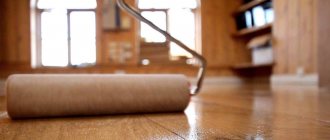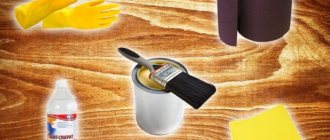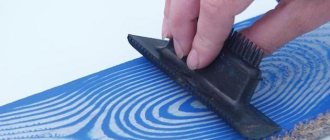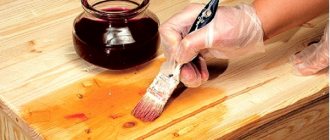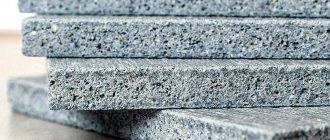In order not to lose the quality characteristics of wood, it is recommended to treat it only with natural compounds. Various natural oils have been used for treating wood since the 12th century. In terms of its characteristics, linseed oil takes first place, as it not only protects wood, but also gives it a soft, velvety shade. How to properly use linseed oil for wood processing, the main stages and subtleties of the work in one short article.
What is flaxseed oil
The modern building materials market offers a fairly wide range of protective compounds for wood. Many of them surpass linseed oil in their technical characteristics. But the latter does not give up his positions. The reasons are the environmental friendliness of the material, high antiseptic properties, plus the ability to emphasize the natural texture of the wood.
The advantages include properties such as filling microcracks that form between the fibers. And it is known that it is in cracks of this type that moisture accumulates, which reduces the quality of the tree itself. At the same time, linseed oil, penetrating deep into the wood structure, increases the elasticity and plasticity of the top layer. And this is protection against the formation of microcracks.
Linseed oil is an excellent water-repellent layer Source impra.de
The resulting protective film is an excellent water-repellent layer. At the same time, the molecular structure provides high adhesive properties. That is, the oil easily lays on the wood without peeling off from it. Let us add that after drying, the formed film does not support combustion, which is an important quality for finishing wooden products and structures. And another plus is low consumption. On average 60 g/m². Of course, taking into account the multi-layer application, the material consumption increases. But this depends on the porosity of the wood. The softer and more porous it is, the greater the oil consumption, because it is absorbed and fills the pores.
The flax impregnation itself is obtained by squeezing flax seeds. Technology can be cold or hot. In the first case, the seeds are simply pressed. In the second, they are first exposed to temperature.
There is a certain classification of this material depending on the amount of impurities in it:
- refined with the amount of impurities up to 0.05%;
- unrefined with the amount of impurities in the range of 0.05-0.15%.
It is the second one that is used for processing wooden structures and products.
Processing wooden products with linseed oil Source ytimg.com
The market today offers two modifications of this material: pure oil without additives and with additives. The latter type is called drying oil or impregnation. The second differs from the first in that the oil undergoes a heat treatment process, and then chemical additives are added to it. The latter are necessary in order to reduce the polymerization time of the material. In ordinary words - the drying process. Sometimes drying oil is called boiled oil or boiled oil.
Treating wood with flax oil is a simple process. But it is necessary to take into account the low polymerization of the impregnation. Firstly, the protective material is applied in 5-7 layers, depending on the porosity of the wood. And each layer can dry for several days, which increases the time for carrying out protective measures for the tree. Secondly, the impregnation is actively absorbed into the wood structure, hence the number of layers.
Thirdly, linseed oil that has penetrated deep into the body of a wooden structure takes a long time to dry. And the surface layer quickly. Hence the oil stains that constantly appear on the surface. Fourthly, the dried material is afraid of mechanical stress. That is, it has high abrasion. Scratches also often appear on the treated surface.
Attention! The oil layer dries well in the sun. This only takes a few hours. But the material becomes darker from sunlight. Not everyone likes this.
Treating a wooden floor with linseed oil Source allegroimg.com
See also: Catalog of companies that specialize in paints and finishing materials and related work.
In this regard, drying oil is better. It is practically not absorbed into the wood structure, leaving a durable film on the surface. Quick drying is another important advantage. And thirdly, even under the sun, drying oil does not darken. By the way, it dries within 24 hours if the temperature is within +20C and the air humidity does not exceed 80%.
Despite a fairly large number of shortcomings, craftsmen still use linseed oil to impregnate wood. It is used to treat external and internal surfaces of wooden walls, ceilings, wooden dishes, furniture, windows and doors, toys, etc. Products and structures made of valuable wood species are especially impregnated with this type of oil. In this way, the natural qualities and properties of expensive wood are preserved for a long time.
Impregnation of wooden furniture with linseed oil Source roomester.ru
Application technology
Each manufacturer's use is indicated on the label. But there are standard methods:
- Immersion - when a wooden element is immersed in a hot composition and left to soak for several days. Then it is taken out and dried on a warm surface.
- Vacuum impregnation - the product is placed in a special device, where, under the influence of a vacuum, the oil penetrates deep into the wood.
- Two-layer application - performed using a brush or a piece of foam rubber when finishing the premises.
Let's take a closer look at two-layer application, which is suitable for treating wooden floors, stairs and walls.
Rules for applying linseed oil
Like most construction processes, impregnation of wood with linseed oil is divided into two stages: preparation and application itself. Processes included in preparation:
- sealing cracks and cracks with repair compounds;
- primer, preferably alkyd;
- surface grinding;
- dust removal, preferably with a compressor, that is, a stream of air under pressure;
- cleaning - usually treated with white spirit;
- If a log house is treated with linseed oil, it is pre-treated with an antiseptic.
Attention! Wood moisture content should not exceed 15%. Otherwise, linseed oil will not be absorbed into the structure of the product and will take a long time to dry.
Applying oil with a swab Source ales-spb.ru
Oil application technology
Stages of work
Work on processing a house made of timber or a log house will be similar. Conventionally, they can be divided into three main stages:
- Surface preparation. This stage includes surface cleaning and grinding. If you are painting a new house with a painted surface, first of all, remove the old paintwork.
- Priming and antiseptic. This step is required if pure oil is used. If processing is carried out by professional means, you must follow the manufacturer's recommendations. Some impregnations already contain an antiseptic and primer, which must be indicated in the instructions.
- Direct application of impregnation.
The process of applying oil to wood is described in detail in the article “How to treat a wooden house with oil with your own hands.” Therefore, in this review we will not dwell on the description of all stages, but will provide only the basic rules for oil painting.
Oil painting rules
Before starting work, it is necessary to determine the moisture content of the wood.
The optimal indicator in this case is 15%. Air humidity during painting is also essential. It should be within 80%.
Conifers with high resin content must first be impregnated with white spirit.
When painting wood with pure linseed oil, at least 4 layers are required to obtain a better result. When using professional products, you must follow the manufacturer's instructions. As a rule, to achieve the desired effect, impregnation manufacturers recommend applying 2 layers to unpainted wood and one to painted wood.
The oil should be applied along the grain of the wood using a stiff brush with artificial bristles or a lint-free cloth.
Be sure to sand between layers after each layer of oil has dried.
After the last layer has completely dried, the wood is polished with suede. Polishing allows you to give the surface an even, beautiful shine.
To check the quality of the resulting coating, you can apply a few drops of water. If the liquid remains in place, then the treatment was done well.
Video description
The video shows the process of treating wood with linseed oil:
Today, manufacturers offer a wide range of mineral oils for wood based on linseed components. They are classified as professional impregnations. They differ from pure oil by additives. Usually these are wax, resins, plasticizers, antiseptics, fire retardants, drying accelerators, pigments, etc. These impregnations are classified into two groups: for external and internal work.
Impregnations with the addition of wax are especially popular among craftsmen. This is actually a high quality material among its kind. They are usually used to treat the surfaces of wooden structures that are subject to intense loads. For example, stairs, floors, doors and some types of furniture.
And one more point that can be attributed to the advantages of impregnations of this type. Wood coated with linseed oil wears out over time, loses its original color, and scratches and other minor defects appear on the surface. These shortcomings can be easily corrected. To do this, the old treated surface is sanded with fine-grained sandpaper and a layer of oil is applied. The latter will hide all the unpleasant moments and give the wood a new attractive appearance.
Restoration of old furniture with linseed oil Source wp.com
Wood impregnation at home
Impregnating compositions from linseed oil are easy to prepare at home. The easiest way is to boil it twice.
The portion required for one use is heated in a water bath until it boils, then cooled and boiled again. As a result of heating, unstable impurities are destroyed. When purifying raw oil, hydrofiltration is sometimes used: it is combined with water before boiling and then filtered.
To ensure the smoothness of the coating, extend the service life and increase water-repellent properties, you can add beeswax to homemade drying oil. If thick mastic is required, oil and wax are taken in a 1:1 ratio, for liquid impregnation - 2:1.
The bee product for wood processing is pre-crushed and combined with fat when heated, after melting it is mixed until completely homogeneous. The composition remaining after the work is stored in a cool place in a hermetically sealed container and heated if necessary.
When immersing wood, the mixture at a temperature of 60°C is poured into a steel or enamel container and the items are soaked in it for 2–3 hours. Then they are taken out, the remaining oil is blotted with a soft cloth or paper and the items are dried for 2–4 days. Finished surfaces are polished with suede to a shine or varnished as desired.
Layering requires more effort and takes longer.
To work you will need:
- oil mixture; fine-grained sanding paper; sponge, brush or roller; clean rag; piece of suede.
Fresh boards are thoroughly dried before processing; their moisture content should not exceed 15%. Impregnation is carried out in a dry room or outdoors in clear weather.
All work is done with gloves. The material is sanded, smoothing out irregularities, cleaned of sawdust and wiped with a dry cloth. The composition heated to +60–70°C is applied along the fibers with a brush or other convenient tool. Dry porous wood absorbs hot oil almost without residue, so after the first application it usually requires repeated application after 10–15 minutes. The oil must be carefully rubbed into the finely porous material so that it does not spread and is evenly distributed over the surface. Stop working after the board begins to varnish shine. The oil-coated boards are left alone for another 30 minutes, then the remaining composition is removed with a sponge, and the wood is left to dry. For drying oil, this period is on average 24 hours; if natural linseed oil without additives is used, drying can take more than 3 days. The second layer is applied to the products after the previous one has completely dried.
The procedure is carried out in a similar way. Depending on the type of wood, it is necessary to apply not 2, but more repeated layers with a period of several days in order to achieve a dense, uniform outer layer. When the wood is completely ready and becomes dry, it is polished with suede, achieving an even shine. Check the quality coating can be done by applying a couple of drops of water to the surface. If after a few minutes the moisture remains in place, the wood has been impregnated well. You can see the qualities of impregnations based on linseed oil in this video: Linseed oil penetrates into the depth of wood by 2–3 mm, which allows it to provide sufficient protective properties for several months. Impregnation can be renewed at any time after the coating ceases to perform its functions and begins to deteriorate. Upon completion of work, all used materials - brushes, sponges, rags - must be immediately soaked in water, and rags and paper destroyed. Flaxseed oil oxidizes easily in air and can cause spontaneous combustion.
People have used linseed oil on wood for many years as a protectant and to improve the appearance of the surface. With the development of technology, the synthesis of artificial resins and powerful antiseptics, the old method still remained in demand: impregnation of wood with linseed oil is indispensable where the requirements for environmental friendliness are unusually high. These include tableware, children's toys, and interior elements.
Other types of oil impregnations
Linseed oil for impregnating wood is not the only thing that manufacturers offer. There are other varieties.
Tung oil
This ancient product is known as a protective impregnation for wood against various bugs, rot and moisture. Therefore, in the old days they treated not only floors and walls, but also furniture and wooden utensils.
Today, tung oil is sold in all hardware stores and is in demand. The method of application is practically no different from linen. Namely:
- application is possible at temperatures not lower than +15C; at low temperatures it thickens, which complicates the impregnation process;
- the material is applied with a brush, then allowed to sit for about twenty minutes and rubbed on the wooden surface with a sponge, evenly distributing it over the entire area;
- It is allowed to dilute the oil with white spirit up to 40%, this increases the absorbency of the material.
Tung oil for wood processing Source nojinsk.ru
Oil properties
To preserve the quality of wooden products for as long as possible, special impregnating agents are used that create an external protective coating.
Natural oil compositions have some advantages in this regard, as they do not harm health. Flaxseed oil for impregnating wood is considered one of the best. It contains a high content of linoleic acid, which promotes polymerization - oxidation in air and the conversion of the substance to a semi-solid state. When applying a natural plant composition to the surface, several goals are achieved:
- the wood becomes protected from dampness, fungal attack, cracking, darkening, premature rot, acquires moisture and dirt-repellent properties; the natural structure of the material is emphasized; minor defects of the products are masked: roughness, scratches; the appearance of the wood improves: the color is evened out, a soft shine appears; it lasts longer service life of materials; wood’s ability to exchange air is preserved; there is no unpleasant chemical odor characteristic of most synthetic impregnations; there is no danger of intoxication.
Treatment of wooden products with linseed oil is absolutely harmless to people and animals, and can be used on any surface, including children's toys, kitchen cutting boards, countertops, spoons, bowls. This coating can be used on any type of wood: yew, birch, oak, pine , ate. Wood oil acts as an antiseptic and is suitable as an independent or intermediate coating if paint or varnish is subsequently required.
Briefly about the main thing
Linseed oil is used to treat wooden surfaces to create a moisture-proof film and cover minor defects.
Apply the oil to the prepared surface: sanded, clean and dry.
For application use brushes, rollers or sponges.
To treat large surfaces, use a spray bottle. The main task of the work manufacturer is to apply the material evenly.
In addition to linseed oil, manufacturers offer tung, teak and tar oil.
Ratings 0
How to treat the outer surface?
Surface preparation is simple. It is simply cleaned of dust and dirt.
If there is old paint, it is removed. Due to their resinous nature, it is recommended to pre-treat coniferous species with white spirit. This will increase the degree of penetration into the wood and make its surface structure more uniform. That is, the first rule is this: linseed oil for impregnating wood is always applied to a clean surface.
Second point. With any method, linseed oil is applied to cover the wood in several layers.
From two to seven. And after each time it is recommended to remove the raised lint. This is done with fine-grained sandpaper.
In cases where the product cannot be immersed in an oil bath, it is protected by painting (large furniture, elements of house construction). To do this, simply apply with a brush with artificial bristles or a lint-free cloth swab.
To increase penetration deep into the wood, the first layers of coating can be made with oil diluted with turpentine. But you just need to make sure that it is natural gum turpentine - the so-called turpentine oil.
Repeated layers are applied only after the previous one has dried. The treatment is repeated until the oil is absorbed. A surface with a uniform matte sheen indicates saturation of the pores.
Wood treated with linseed oil becomes water-repellent
To reduce the absorption of the last layers, you can make a mixture of oil and natural wax. The latter is heated in a water bath, and then oil is added to it.
And mix without removing from the bath until the mixture becomes homogeneous. The ratio of oil to wax is from 2:1 to 1:1 - depending on the desired thickness. Wax provides additional protection against water and gives the surface a noble, quiet shine.
Preparatory activities and procedure for covering wood
Regardless of the chosen method of processing wood products, before starting impregnation, they should be thoroughly prepared for this procedure. To do this you will need to take the following steps:
- First of all, each protected wooden part or individual workpiece must be cleaned of dirt and thoroughly dried.
- If there is an old coating on the wood, it must be removed using sandpaper of a suitable grain size.
- If re-impregnation is being done, to improve its penetration into the wood structure on the already treated surface, I advise you to go through the same sandpaper again
- Mix the linseed oil thoroughly before starting the impregnation; At this point the preparatory stage can be considered complete.
Upon completion of all of the above operations, you can proceed to the main operating procedures. When carrying out direct protective work, well-mixed linseed oil is first applied in two layers, after which it should be allowed to absorb well and dry for a certain time. Try to complete all necessary operations within an hour, after which remove excess impregnating composition with a previously prepared soft rag.
Important! When applying impregnation directly, try to move the brush in the direction of clearly visible wood fibers.
A surface treated with high-quality oil under normal conditions dries for at least a week, after which you can proceed to polishing it with natural wax.
After final processing, the surface of the wood product acquires a pleasant natural shade, on which the features of its texture are clearly visible. At the same time, its resistance to mechanical stress, as well as to ultraviolet radiation, increases. I advise all their owners to carry out this treatment of the external surfaces of wooden buildings annually.
How long does it take to dry?
There is no clear answer to the question of how long it takes for linseed oil to dry on wood.
Depends on temperature, wood porosity, degree of oil purification and other factors. On average, unprepared oil takes a week to dry. Although the process can be greatly accelerated.
To reduce the polymerization period, linseed oil for wood processing is pre-boiled two or three times (an archaic method of obtaining drying oil). Better in a water bath. At the same time, you need to understand that boiling oil is not much like boiling water - the bubbles will be small, and as if suspended in the thickness.
It is permissible to add a drier. The best natural and harmless option is pine rosin. It is either diluted in alcohol and added to boiling oil, or melted in a container into which the oil is then poured and the whole thing is boiled together.
There is also a complex method: boiled oil, rosin, wax and gum turpentine are mixed in approximately the ratio 1(2): 0.1(0.03):1:1. This composition dries quickly and penetrates well into the pores.
Method for stabilizing wood products
Wood is not the most resistant material to biological damage and changes in humidity.
This feature is explained by the porosity of the structure. To improve the consumer properties of this material, various protective compounds are used. Some of them form a surface film, but there are also those that penetrate deep into the structure. Among vegetable oils there are non-drying ones (olive, almond and others) and drying ones (linseed, hemp, poppy seed, nut and a number of others). The latter polymerize over time, forming a dense film insoluble in organic solvents. Artists were the first to appreciate this property - oil paints and varnish in icon painting, for example, were made on the basis of linseed or nut oil (the composition has not changed today).
If wood is treated with linseed oil carefully enough, it penetrates deeply into the pores and dries, forming with the wood a polymer with interesting properties: resistant to decay, dense, does not absorb water, and very decorative. This process is called “stabilization”, since the wooden product stops responding to changes in humidity and does not change its properties over time. At the same time, the material continues to breathe and remains permeable to oxygen.
Technologically, stabilizing wood with linseed oil is quite simple, although it requires compliance with some technological nuances.
Oil processing technology
There are several approaches to the protective treatment of wood using linseed oil, which involve:
- immersing carefully prepared workpieces in a boiling impregnating mixture;
- surface preparation followed by treatment with oil heated to the required temperature;
- so-called “vacuum” impregnation.
The first of these methods is usually used when it is necessary to process small-sized wood blanks (most often these are decorative handicrafts). When preparing the material for processing the walls of a building under construction, I recommend using a more simple-to-implement surface impregnation with a mixture heated to the required temperature. To do this, you just need to bring the impregnating composition itself to the desired condition, and then apply it to wooden surfaces using a regular paint brush.
To implement the last of these methods, you will need a vacuum pump, through which air is removed from the pores of the wood. After “squeezing out” the air layer with this tool, its place is taken by a layer of linseed oil, during the polymerization of which the surface of the timber acquires the required structure.
The high cost of the pump, as well as the one-time nature of vacuum procedures, make it pointless to purchase it for permanent use.
I advise you to agree on the temporary use of this expensive tool with one of your friends or rent it from professionals for the period of processing.
Industrial impregnations
The domestic market offers a wide range of special impregnating agents made on the basis of linseed oil. Special impregnating primers intended for treating the internal and external surfaces of buildings are in high demand among consumers. This wood primer dries quickly enough (no more than 4 hours) and can be used for any type of wood.
I advise everyone who wants to paint their home with natural dyes to purchase painting material from the “NATURA” brand, which, in addition to linseed oil, also contains special mineral pigments. In addition, manufacturers have developed special paste-like pigment dyes, which, when mixed with linseed oil, form the composition of the required shade.
You can familiarize yourself with the procedure for preparing it and applying it to the surfaces to be treated in the instructions supplied with the paste. If you haven’t had time to treat a wooden house, read the article “How to get rid of mold“
